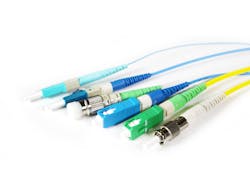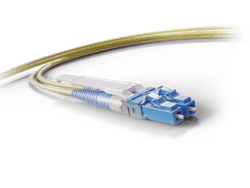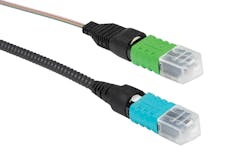By Patrick McLaughlin
The splice-on connector (SOC), a component widely available from fiber-optic suppliers, has established itself as a popular option for data center applications. A combination of quick termination time and cost-efficiency gains has contributed to the SOC’s popularity
In its Reference For Fiber Optics, the Fiber Optic Association (FOA) explains the SOC’s popularity “started in data centers for singlemode fiber, where the number of connections is very large so the cost of a fusion splicer is readily amortized and the speed of making connections is the real cost advantage. The cost of fusion splicers has been dropping to near the cost of a mechanical splice connector kit, so the financial decision to use SOCs is easier to make. The performance of SOCs is much better than prepolished/splice (mechanical splice) connectors simply because of the superiority of a fusion splice over a mechanical splice, and the cost of the SOCs are much less since they do not have the complex mechanical splice in the connector.”
Brad Everette, general manager of UCL Swift Americas, which produces fiber-connectivity technologies including fusion splicers and SOCs, adds, “Expansion of products utilizing fusion splicing as a connectivity termination method is expanding the utilization of fusion splicing beyond the traditional outside plant world. Contractors can now use their splicing equipment to termination SOCs and rack-mounted cassette modules in their enterprise and data center segments, which offer a broader return-on-investment calculation for the splice purchase.”
Installation advantages
The FOA continues, “Termination with a SOC is simple. The fiber to be terminated is prepared as usual: strip, clean, cleave and insert in the splicer. The connector is placed in a holder that positions it in the cleaver to cleave the fiber at the proper length. The holder is inserted in the splicer, the program is run to make the splice, and a heat-shrink protector completes the process.”
As part of its offering of technical resources, Fiber Instrument Sales (FIS) produced a document titled “Why Use Splice On Connectors?” Within that document the company explains, “SOCs were developed to address the cable management and space considerations of connectorized pigtails. Instead of a long pigtail, the body of the SOC contains a short fiber stub—essentially a micro pigtail—to which the field fiber can be fused. Because the splice protection sleeve is contained within the connector assembly underneath the boot, there is no need for a splice tray, splice chips or splice cabinet.
“SOCs greatly simplify cable management for any fiber-optic network,” FIS continues. “SOCs require no extra rack space and eliminate the need for slack cable management. This advantage is especially important for data centers and other high-density applications.”
The company further points out that although SOCs cost more than epoxy-and-polish connectors, using SOCs is cost-effective because they are faster to install and require less technical training or expertise than epoxy-and-polish connectors.
“With the development of splice-on connectors, the fiber-optics industry rose to the challenge of developing a better way to install fiber-optic connectors,” FIS concludes. “SOCs minimize insertion loss, simplify cable management, and they are quick and easy to install. Today SOCs are available in a wide range of connector styles.”These various connector styles are available from a number of suppliers. Sumitomo Electric Lightwave, for example, offers its Lynx CustomFit 2 SOCs in SC, LC, FC, and ST styles. “Customized, on-site field terminations and cable builds at exact lengths are made possible with the Lynx CustomFit 2 Splice-On Connectors,” the company says. “The Lynx2 is a fully integrated splice-on fiber-optic connector enabling quick, easy, and reliable customized FTTx, outside-plant, and inside-plant permanent field terminations without the shorts, excess slack, and logistic delays of preterminated cables.”
The Lynx2 SOCs, Sumitomo adds, “eliminate the necessity and costs of maintaining an inventory of splice trays and varying lengths of preterminated jumpers.”
The company also offers a high-density duplex LC SOC, which incorporates a push/pull tab. Sumitomo says these types of connectors “are required in high-density panels and cassettes where fingers can’t reach the release mechanism of traditional non-tabbed connectors.” Before the push/pull tab was available “special tools were required to remove connectors in this application,” the company added.
MPOs on the scene
Sumitomo also offers an MPO SOC as part of its Lynx2 product line. It states, “The breakthrough technology of the Lynx2-MPO meets the needs of the network for greater optical fiber density and addresses the connectivity demands for faster and easier terminations, upgrades, repairs and restorations, and significant cost savings required for today’s data center, enterprise network, outside plant, OEM, central office, and virtually any FTTx network application.
“MTP-compatible, the Lynx2-MPO is a solution for optical fiber ribbon and loose-tube round cord and patch cord terminations,” the company says. The Lynx2-MPO allows the technician to make permanent terminations with the exact cable length for fast and easy installations and upgrades at the work site. The on-site customization facilitated by the Lynx2 connectivity method eliminates the risk of shorts and slack, repair lag, and logistics delays.”
AFL recently updated the MPO connector in its FUSEConnect SOC product line. “The FUSEConnect MPO’s updated design migrates from a mechanical splice protection clamp to a heat protection sleeve, using an on-board splicer heater and eliminating the need for a separate mechanical clamp tool,” AFL said when announcing the update in February 2021. “Design to utilize standard ribbon, SpiderWeb Ribbon, or loose-tube cable, this connector helps minimize the complexity involved in the termination of multifiber connectors.”
“As we explored ways to improve on the FUSEConnect MPO, we focused on the viewpoint of field technicians—how could we adapt this connector to make it easier during installation?” explained Sadie Waycaster, optical connectivity product manager at AFL. “The result is in the process. By using a heat-sleeve protector design, the overall termination process is cleaner, faster and more efficient.”
The connector’s factory-prepolished ferrule allows for a field termination process that eliminates the need for polishing, adhesives and crimping in the field, and minimizes the potential for operator error and connector scrap. It is designed to be used with the RT-02 ribbonizing tool, which does not require glue, resulting in a clean termination process.
AFL’s FUSEConnect SOC product line also includes SC, LC, ST, and FC connector styles. The company offers a toolkit as well as accessories for FUSEConnect MPO application.Panduit also offers a splice-on MPO connector. In literature describing this connector type and its applications, the company says, “MPO splice-on connectors enable rapid deployment of high-performance field terminations for today’s data center applications. Field termination allows for deployment of customer fiber links without added time and planning typically required for preterminated assemblies, while using the real-time splice-loss calculations of typical fusion splice machines to enable confidence in component performance.
“Splice-on connectors can be used for initial installation of fiber links, moves/adds/changes work, or repairs to existing links to minimize downtime. Fusion splice connectors also allow for higher-performance links through lower insertion loss and higher return loss characteristics.”
Available in a variety of connector styles, including MPOs commonly used in data centers, splice-on connectors continue to penetrate the fiber-optic networking space.
Patrick McLaughlin is our chief editor.



